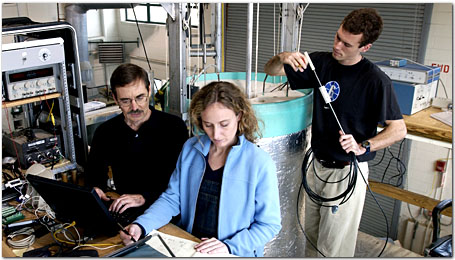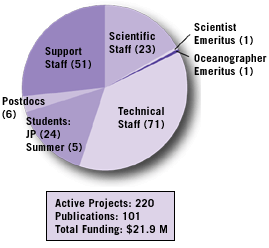
|
 |
Research > Departments > Applied Ocean Physics and Engineering
Applied Ocean Phyics and Engineering Overview
Overview | Awards and Recognition
 |
| Applied Ocean Physics and Engineering Department Assistant Scientist Andone Lavery, center, works on a tank experiment with Ray Schmitt, left, Senior Scientist in Physical Oceanography, and Joint Program Student David Stuebe. They are developing a technique for measuring acoustic scattering from the microstructure (small-scale physical characteristics) occurring at the boundaries between layers of seawater with different physical properties. (Photo by Tom Kleindinst) |

|
The Applied Ocean Physics and Engineering Department (AOPE) comprises a diverse group of engineers and scientists who push the frontiers of technological innovation as they observe and model the ocean. Research projects include fundamental investigations of ocean processes, acoustics, signal processing, and vehicle dynamics. Teams of engineers and technicians develop and deploy instruments, moorings, and vehicles in support of research both at WHOI and in the larger oceanographic community.
The Department is renown for its deep-sea research vehicles, notably the 4,500-meter (14,764-foot) human-occupied submersible Alvin. The Deep Submergence Laboratory launched the second-generation, 6,500-meter (21,450-foot) remotely operated vehicle Jason in 2002 (see Science Highlights story on Jason). This vehicle’s imaging capabilities set the standard for oceanographic studies, and the associated image processing is an important AOPE research area. Department staff also develop and operate several autonomous underwater vehicles, including small, agile ones for shallow-water, high-energy environments and efficient, high-endurance vehicles for abyssal exploration. Other AOPE engineering activities include development of mooring systems, advanced sampling devices, and sensing systems.
The Department’s scientific projects encompass a wide range of disciplines and ocean environments. Acousticians investigate the propagation and scattering of sound in the ocean, from the microscopic to ocean-basin scale. Related research focuses on communication and signal processing. Fluid dynamicists investigate physical processes in the ocean such as turbulent mixing, surf-zone dynamics, internal waves, coastal circulation processes, and interdisciplinary studies. The fluid dynamics subgroup focuses on air-sea interaction, which is of particular relevance to the role of the oceans in climate change.
Two Assistant Scientists hired in 2002 enhance the intellectual breadth and diversity of the Department. Houshuo Jiang studied meteorology and atmospheric dynamics at Nanjing University in China and holds master’s and PhD degrees in oceanography from The Johns Hopkins University. He employs numerical models to investigate the small-scale fluid dynamics associated with marine organisms. Andone Lavery studies the acoustic scattering signature of organisms and turbulent microstrucuture with the objective of developing theoretical and experimental bases for distinguishing them (photo above). Andone holds an undergraduate degree in mathematics from the University of Cambridge and a PhD degree in physics from Cornell University.
—W. Rockwell Geyer, Department Chair
|
|
